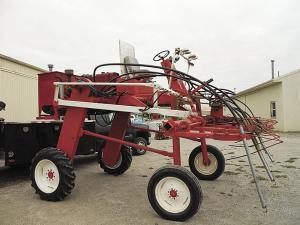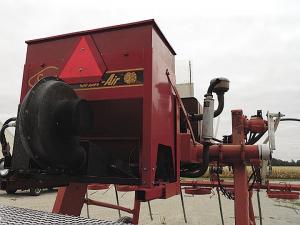He Uses Detassler To Seed Cover Crop
Nick Renner turned a used detassler into a cover crop seeder. Renner is a longtime no-tiller who recently got interested in the benefits of cover crops. Combining the detassler with a used Gandy air seeder was a low cost way to experiment with getting a cover crop started in standing corn.
“I figure a good nitrogen-producing cover crop could reduce inputs by $150 to $200 per acre, once we get things worked out,” says Renner. “If we can plant in-crop, we can pick up a month to 6 weeks of growing time in the fall.”
Until he retired a few years ago, Renner ran a farm for his religious order, the Missionaries of the Precious Blood. He and a co-manager had converted the farm to no-till by 1985. Though it’s now rented out, Renner still oversees it and requires that it be no-tilled. He sees cover crops as a way to cut costs and help the soil.
“Cover crops put starches and sugars into the soil all winter, feeding the bacteria and fungi in the soil,” he says. “Cover crops let us mimic Mother Nature.”
To make his seeder, Renner took the 6-row corn detassler, which straddles 3 rows, and added 2, 3-row wings to it. He mounted a Gandy air seeder and routed drop tubes between rows.
The first year, he retained all cutting heads and cut the cornstalks above the ears as the kernels were entering the black layer stage.
“The top of the stalk isn’t needed at that point,” he says. “The idea was to open up the rows so more light would get down for cover crop germination. This past year, I clipped only three rows in cooperation with Ohio State University researchers to evaluate the effect on corn crop dry down.”
Both years were frustrating for Renner. Fall 2010 was dry, and harvest was early enough that there was limited advantage from in-crop seeding. The dry weather reduced or prevented germination until the following spring. Fall 2011 was wet and cold, delaying entry into fields pre-harvest.
“I think a more average year would produce better stands,” suggests Renner. “This year some stands came up perfectly; some were just good. We’re still learning.”
The diesel mechanics class at a local school is overhauling the engine for Renner in preparation for seeding this fall. They are also rebuilding the manifold to allow Renner to eventually expand the machine to 24 rows. He is unsure how many rows he will clip in the future.
“If we were to clip 12 rows or more, we would need a larger motor,” he says.
Renner estimates he has about $6,000 invested in the machine at this point. He hopes to do a year or two more of testing, noting that others have already picked up on his concept and built even bigger and better seeders.
Contact: FARM SHOW Followup, Brother Nick Renner, 229 W. Anthony St., Celina, Ohio 45822 (ph 419 852-2917; nrenner@celina-ic.org).

Click here to download page story appeared in.
Click here to read entire issue
He Uses Detassler To Seed Cover Crop CROPS Miscellaneous Nick Renner turned a used detassler into a cover crop seeder Renner is a longtime no-tiller who recently got interested in the benefits of cover crops Combining the detassler with a used Gandy air seeder was a low cost way to experiment with getting a cover crop started in standing corn “I figure a good nitrogen-producing cover crop could reduce inputs by $150 to $200 per acre once we get things worked out ” says Renner “If we can plant in-crop we can pick up a month to 6 weeks of growing time in the fall ” Until he retired a few years ago Renner ran a farm for his religious order the Missionaries of the Precious Blood He and a co-manager had converted the farm to no-till by 1985 Though it’s now rented out Renner still oversees it and requires that it be no-tilled He sees cover crops as a way to cut costs and help the soil “Cover crops put starches and sugars into the soil all winter feeding the bacteria and fungi in the soil ” he says “Cover crops let us mimic Mother Nature ” To make his seeder Renner took the 6-row corn detassler which straddles 3 rows and added 2 3-row wings to it He mounted a Gandy air seeder and routed drop tubes between rows The first year he retained all cutting heads and cut the cornstalks above the ears as the kernels were entering the black layer stage “The top of the stalk isn’t needed at that point ” he says “The idea was to open up the rows so more light would get down for cover crop germination This past year I clipped only three rows in cooperation with Ohio State University researchers to evaluate the effect on corn crop dry down ” Both years were frustrating for Renner Fall 2010 was dry and harvest was early enough that there was limited advantage from in-crop seeding The dry weather reduced or prevented germination until the following spring Fall 2011 was wet and cold delaying entry into fields pre-harvest “I think a more average year would produce better stands ” suggests Renner “This year some stands came up perfectly; some were just good We’re still learning ” The diesel mechanics class at a local school is overhauling the engine for Renner in preparation for seeding this fall They are also rebuilding the manifold to allow Renner to eventually expand the machine to 24 rows He is unsure how many rows he will clip in the future “If we were to clip 12 rows or more we would need a larger motor ” he says Renner estimates he has about $6 000 invested in the machine at this point He hopes to do a year or two more of testing noting that others have already picked up on his concept and built even bigger and better seeders Contact: FARM SHOW Followup Brother Nick Renner 229 W Anthony St Celina Ohio 45822 ph 419 852-2917; nrenner@celina-ic org
To read the rest of this story, download this issue below or click
here to register with your account number.








